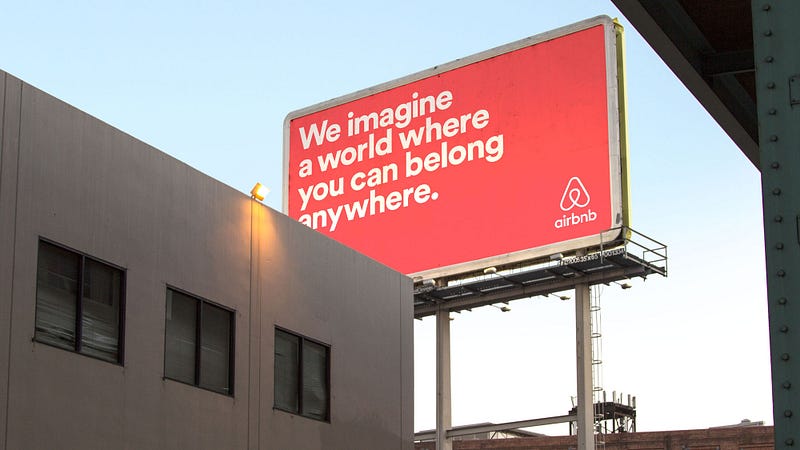I have stage fright. I love the high of public speaking but every speech is preceded with heavy anxiety.
That’s why, when the talk is over, I can lose focus during the audience Q&A afterward. With the stress of the presentation behind me, I’m a little less than present in answering the questions people ask while I’m still on stage.
“Damn, I had a better answer than that.” Invariably, this thought runs through my head on the drive home, and a recent talk I gave on brand strategy is no exception.
An audience member asked me how to name a brand, especially in crowded markets where it seems like every name, from viable to ridiculous, has been taken. My answer started with, “I’m not a naming expert but…”
…but that’s not true. Naming is simply another brand challenge that can be approached with smart frameworks, and is in fact a challenge I have solved for many clients.
The right name can be the first step in creating an entire market or, as I mention below, the beginning of a powerful brand narrative that changes the behaviors of your target consumers.
A name is more than a brand. It’s a signal. It’s the first declaration you make as a company, and what you say in that declaration will set every consumer expectation and belief that comes after it. If you’re going to start that conversation, you’d better have a strategy for guiding it in the right direction. Brand strategy and naming strategy need to amplify one another.
As more and more people ask me this specific naming question — how to create a unique name that stands apart without losing value.
I’d like to offer clear best practices that can guide anyone at any stage.
- The first section describes my thoughts for successful, original naming
- The second section goes into the exercises that worked for me personally as we rebranded our company from J.B. Communications to Concept Bureau
- …and the third provides a long list of best practices I’ve found in my research (with the generous help of Jean-Louis Rawlence, CSO of Concept Bureau.)
It’s by no means comprehensive, so if you have any published research or thinking to add, hit me up.
One Of These Names Is Not Like The Others: 3 Paths to Originality
Being original in your name without breaking an authentic connection with your audience is perhaps the biggest brand naming challenge founders face today. If you want to be original, you have to think strategically.
Cheap tricks like removing vowels or focusing on phonetics are dated and don’t always work, especially if you’re trying to disrupt old, trust-based institutions like finance, insurance or housing.
That goes double for CPG brands that are asking consumers to change vital human behaviors like the way we eat with food tech, or how we medicate with health tech.
1. Create a movement, not a cause
People have to rally around an ideal that forces them to act. This point is especially true for non-profits and charities.
A cause is a feature. A cause is to plant more trees, end poverty or feed children. It’s a voting platform, better coffee or any number of characteristics that are a means to an end or a relief to a pain point. Causes sound like Save The Children, Alzheimer’s Association, Disabled American Veterans and Big Cat Rescue.
The problem with causes, especially in the non-profit sector, is that they often operate on guilt stories — and guilt stories don’t create lasting behavioral change or loyalty among millennials.
Movements, on the other hand, invite you to imagine an alternative future. Think Do Something, Doctors Without Borders, Habitat for Humanity and Teach For America.
The future vision is a compelling benefit. In these specific cases, the benefit is not only a new world reality, but a chance to belong to something much bigger than yourself.
Causes promise immediate solutions (at best). Movements promise a tectonic shift.
2. Make self-identification easy
Think of your audience and what beliefs or perceptions they identify with. What principles define them? What kind of movement or name would they be proud to belong to?
Your name should be something they can align with, either literally or figuratively. The name should echo a larger story that gives your audience meaning.
Keeping with the non-profit thread, Hands Across America was a narrative about acceptance. To say you were a part of that was to own a piece of the legend. Same goes for Make A Wish Foundation and Human Rights Watch.
Startups like Product Hunt and WeWork follow the same path. These are calls to action that begin a larger story and give target audiences a narrative they can align themselves with.
Even a name like LendUp, which is basically alternative payday loans for people with poor credit, tells an enlightened, positively spun story about financial empowerment for young people who may be in a tight spot now, but are still optimistic about their financial future.
Names that create easy self-identification give people a mental hook they can latch onto. It’s an extension of the benefit that compels them to act.
3. Map the consideration set
Once you have a shortlist of names, you can sense-check them against relevant consideration sets. What groups of competitors and substitutes will potential customers compare you against when they make a decision?
Let’s go from hypothetical to real-world here. Below is the map we created when my former agency, J.B. Communications, was looking to rebrand with a new name.
As a brand strategy agency, we looked at the many groups that either competed with, or substituted as, our company offering. We looked at extremes — huge companies that we’d love to one day be competing against, and smaller ones showing up in our territory right now— and listed them along a continuum.
Consideration sets are important because they hearken the familiar and provide context that will inform your potential customer, but they also risk lumping you in with others, providing little or no differentiation.
What’s important with consideration sets is that you want to be able to stand up to them in name. We knew that target clients would also be considering young creative agencies and/ or older consulting and communications firms when looking for brand strategy support.
Not all of these companies are direct competitors, but all of them easily migrate into strategy for their clients.

Not all names will fit perfectly, but you can generally lump them together and look for patterns. In our case, younger creative agencies had more tongue-in-cheek names formed from one or two nouns, while older communications firms went the namesake route.
Our name had to be able to stand apart from both groups, and at the same time stand up to each one. You can see some of our other shortlisted names in red that steered too far in one direction and risked losing uniqueness.
With this map, we could see that Concept Bureau was different enough from each group while being able to hold its ground against any individual name on either side.
You, too, will have consideration sets (oftentimes more than two), and a strong name will be able to fit into each while also being unmistakably distinct.
Find patterns you can break. Keep patterns you want to leverage.
Work Up A Sweat: Exercises To Get Your Brain Going
Exercises are great little hacks for getting your mind working in the right direction, but don’t expect them to directly lead you to your final name.
In our case, as I explain below, these exercises helped me very clearly realize what we are not, so that when I finally stumbled upon the right name, I knew it perfectly represented what we are.
Brand Deck
We used a brand deck to help us narrow in on who we were and what that meant for our name. It’s a simple deck with a brand attribute written on each side. So, for example, a card may say “refined” on one side and “precise” on the other.
You choose an attribute and put it in a pile for You Are, Your Are Not, or Does Not Apply. I’ve always said that good brands are specific, and this is an easy exercise that forces you to make some of those harder brand decisions.
For us, certain choices like “idealistic” vs. “realistic” or “welcoming” vs. “assertive” were surprisingly difficult and made us think.

What I also like about this exercise was that it made us commit. Once we chose a card, we collectively devoted ourselves to that attribute… and each commitment gave us a clearer pathway to the name we were searching for.
Free Association
You’ll quickly begin circling certain attributes that embody your brand, either through the brand deck, group discussion or by way of a larger brand strategy for the marketplace.
You can narrow down some of those words and then begin doing some free association around them. I did ours on a conference call with the team during a long drive home. It certainly doesn’t need to be focused thought. In fact, a small distracting task (like driving or cleaning) can help free up your subconscious a bit.
This is a small sampling of our free association:

We also associated for words like manicure, fruit and sweetness just to see where they’d lead. All of them were valuable and got us thinking outside the box.
Full Survey
There’s a world of name types out there, and getting yourself familiar with them can easily inspire a new naming thread.
Here’s a high-level rundown that I pulled from Wikipedia, but it’s pretty comprehensive. You’ll already understand most of these, although you may not have stopped to consider them.
Pay attention to brands in your day to day life and begin categorizing them to see how they work and what effect they have on you as a consumer.
- Acronyms (IBM) — Each letter representing a word
- Amalgam (Nabisco) — Combination of word components
- Alliteration and Rhyme (Youtube) — Pleasing to say
- Appropriation (Caterpillar) — Borrowing a word for a different application
- Descriptive (General Motors) — Simply describing the product or characteristic
- Clever Statement — (Seven For All Mankind) — An expression
- Evocative (London Fog) — Vivid image
- Founders’ Names (Hewlett-Packard) — A combination of names
- Geography (Cisco) — Location or term for a location
- Humor/Slang or HomeNON — (Yahoo!) — A name with strong personality
- Ingredients (Clorox) — Based on components
- Mimetics (Krispy Kreme) — Alternative spellings for common sounds
- Nickname (Adidas) —A founder’s nickname
- Neologism (Kodak) — Made up word
- Onomatopoeia (Twitter) — Associated sound
- Personification (Green Giant) — Character
- Portmanteau (Pinterest) — Word combination
Anything But A Dictionary
Don’t open a dictionary. Don’t flip through the pages of a thesaurus and randomly place your finger on words. It will lead you astray. You’ll get hung up on meanings and etymologies, and things that sound cool will rarely feel right.
I find that words in books can be helpful when they come in context. After we did a lot of brainstorming and strategizing (and perhaps even some soul searching — rebranding can be a little emotionally taxing, after all) I was confident I’d know the name once I saw it. It was just a matter of digging at that point.
Our name ultimately came from the pages of a Pharrell’s book, Places and Spaces I’ve Been. It wasn’t “Concept Bureau” in the book, but the words emerged from the pages and I put them together.
Here are some more places where you can go digging:
- Coffee table books, comic books, cookbooks, manuals, novels, old notebooks
- Visit museums, art shows, galleries, exhibitions
- Song lyrics, album covers, liner notes
- There’s an ironic name generator for everything — brands, hipster co’s, startups, character names, fantasy names, team names, Wu Tang Clan Names, pirate names— have fun with them and see if they inspire something
- Maps, almanacs
- Comment boards and threads where your audience gathers
- Old speeches, transcripts and movie scripts
- If you’re looking to go the Neologism route, you can use this great tool for creating new words based on the quality, number of letters, and fragments you’d like to include
- You can also invent a word using prefixes, suffixes and core phrases
- …or use this site for a number of word builder tools
What Words Mean: Collected Best Practices From Near and Far
Naming best practices can get tricky. I’d recommend using them to narrow down certain trains of thought, but don’t use them as end-all qualifiers.
Here are some accepted standards almost everyone agrees on:
- Keep it short, under 10 letters and 4 syllables
- “Names that display a consonant-vowel-consonant pattern, like Gatorade, Lipitor, and Amazon, are often easiest to say, since these sorts of letter combinations are among the first that infants learn in any language”
- Alliteration and assonance can be pleasant to a consumer’s ears, but don’t get too hung up on them
- Find the word(s) that evoke the story your consumer wants to hear
- “c,” “v,” and “p” convey liveliness and vigor
If you really wanna get deep…
- Fricatives (consonants produced by forcing air through the narrow channel between tongue and front teeth or tongue and upper palate or tongue and molars: f, s, v, z) convey “faster” and “smaller” — as do vowels that are voiced near the front of the mouth, like the a in “bat” or the i in “hid”
- Plosives (stops or consonants in which the air flow is blocked: b, d, p, t) convey “slower” and “bigger” — as do vowels that are voiced at the back of the throat, like the o in “token” or the double o’s in “food”
- Voiceless stops (such as k, p, and t) are more alive and daring but emote less luxury than voiced stops like b, d and g, which emote more luxury
- … of course all of this depends on context, use and situation, so proceed with caution
The Minimum Viable Name Framework is a way to categorize your name ideas to see where they fall in a spectrum ranging from Benefits and Features to Functional and Emotional.
Each quadrant has benefits, implications and drawbacks. Mapping your competitors and substitutes in each category will provide clarity as well.
Lexicon’s Branding’s Blog is a bit dry, but they have some good articles that make sense of successful names. They’ve named the big name brands out there, and I’d recommend reading this one on how spelling reveals character, and this one about how the sharing economy is affecting naming. Here’s a bonus NYT article on Lexicon itself and the stories behind how they named some of the best known brands out there.
P.S. They’re the researchers behind the insights relating to fricatives, plosives and so on above.







